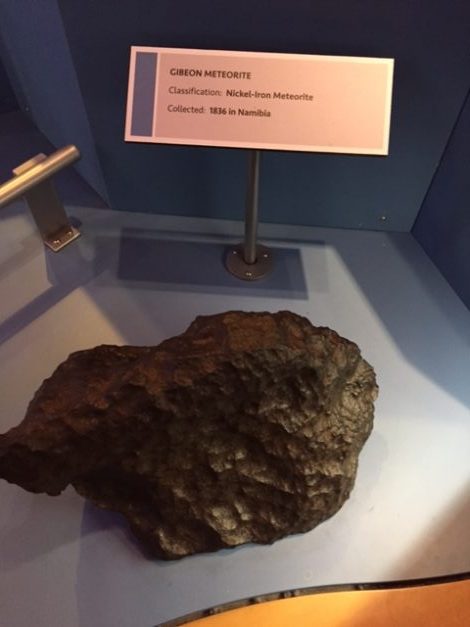Meteorites that landed on Earth
Being held at the Museum of Natural Sciences in Downtown Raleigh, this meteorite is classified as Nickel-Iron. There are many other kinds of meteorites that have landed on Earth throughout history.
February 15, 2017
The Earth is more than 4.5 billion years old. With all of that time, many meteorites have struck its surface. You may remember seeing a meteor shower or wanting to see one as a kid. Meteorites are exactly the same except for the fact that they make it to Earth’s surface. 90 to 95 percent of the meteors that enter Earth’s atmosphere do not survive to become meteorites. Some of the meteorites that have struck the Earth’s surface are currently being stored in the Museum of Natural Sciences in Downtown Raleigh. For example, in March of 2003, meteorite fragments classified as Ordinary Chondrite, which means it is stony, struck the Earth’s surface in Park Forest, Illinois. People from four different states could see the fireball that struck a populated Chicago suburb. These fragments are one of many meteorite discoveries stored in the museum so close to home.
An Ensisheim Meteorite made of the same material from the meteorite from 2003, Ordinary Chondrite, was discovered in 1492, in Alsace, France. In 1836, two different kinds of Nickel-Iron materials were discovered in Namibia, one of which is a gibeon thin section and the other is a meteorite. Another kind of meteorite found that is stored in the museum is the Murchison Meteorite. The classification for it is Carbonaceous Chondrite. It was collected in 1969, in Victoria, Australia.
Meteorites mostly come from breaking apart in the asteroid belt located between Mars and Jupiter. These fragments will often orbit the sun for millions of years before reaching Earth’s atmosphere. Most meteorites are rock, but some are iron or nickel. This means that most meteorites will attract cheap magnets. At the museum, the exhibit will educate you on much more about the meteorites and their significance.
These meteorites, and more, can be seen at the Museum of Natural Sciences in Downtown Raleigh. Junior Sara Beth McLamb said, “It’s really awesome to know that all of these meteorites are being held so close to where I live. I’ll probably visit the museum to see these for myself.” While the museum holds meteorites on the smaller side, some can be very large. In fact, the largest one to strike Earth’s surface found weighs around 60 tons. It is about 9 feet wide, 9 feet long, and 3 feet thick. It is free the go into the museum. Also, it is open from 9AM to 5PM on weekdays and noon to 5PM on weekends.












